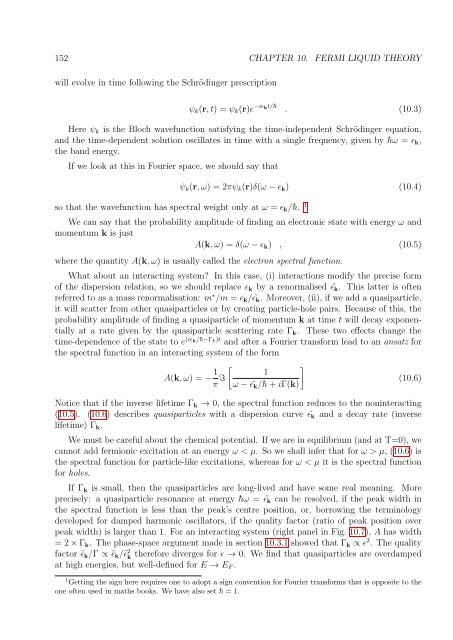Set of supplementary notes.
Set of supplementary notes.
Set of supplementary notes.
You also want an ePaper? Increase the reach of your titles
YUMPU automatically turns print PDFs into web optimized ePapers that Google loves.
152 CHAPTER 10. FERMI LIQUID THEORY<br />
will evolve in time following the Schrödinger prescription<br />
ψ k (r, t) = ψ k (r)e −iɛ kt/h¯<br />
. (10.3)<br />
Here ψ k is the Bloch wavefunction satisfying the time-independent Schrödinger equation,<br />
and the time-dependent solution oscillates in time with a single frequency, given by h¯ω = ɛ k ,<br />
the band energy.<br />
If we look at this in Fourier space, we should say that<br />
ψ k (r, ω) = 2πψ k (r)δ(ω − ɛ k ) (10.4)<br />
so that the wavefunction has spectral weight only at ω = ɛ k /h¯. 1<br />
We can say that the probability amplitude <strong>of</strong> finding an electronic state with energy ω and<br />
momentum k is just<br />
A(k, ω) = δ(ω − ɛ k ) , (10.5)<br />
where the quantity A(k, ω) is usually called the electron spectral function.<br />
What about an interacting system In this case, (i) interactions modify the precise form<br />
<strong>of</strong> the dispersion relation, so we should replace ɛ k by a renormalised ˜ɛ k . This latter is <strong>of</strong>ten<br />
referred to as a mass renormalisation: m ∗ /m = ɛ k / ˜ɛ k . Moreover, (ii), if we add a quasiparticle,<br />
it will scatter from other quasiparticles or by creating particle-hole pairs. Because <strong>of</strong> this, the<br />
probability amplitude <strong>of</strong> finding a quasiparticle <strong>of</strong> momentum k at time t will decay exponentially<br />
at a rate given by the quasiparticle scattering rate Γ k . These two effects change the<br />
time-dependence <strong>of</strong> the state to e (iɛ k/h¯−Γ k )t and after a Fourier transform lead to an ansatz for<br />
the spectral function in an interacting system <strong>of</strong> the form<br />
A(k, ω) = − 1 [<br />
]<br />
π I 1<br />
(10.6)<br />
ω − ˜ɛ k /h¯ + iΓ(k)<br />
Notice that if the inverse lifetime Γ k → 0, the spectral function reduces to the noninteracting<br />
(10.5). (10.6) describes quasiparticles with a dispersion curve ˜ɛ k and a decay rate (inverse<br />
lifetime) Γ k .<br />
We must be careful about the chemical potential. If we are in equilibrium (and at T=0), we<br />
cannot add fermionic excitation at an energy ω < µ. So we shall infer that for ω > µ, (10.6) is<br />
the spectral function for particle-like excitations, whereas for ω < µ it is the spectral function<br />
for holes.<br />
If Γ k is small, then the quasiparticles are long-lived and have some real meaning. More<br />
precisely: a quasiparticle resonance at energy h¯ω = ˜ɛ k can be resolved, if the peak width in<br />
the spectral function is less than the peak’s centre position, or, borrowing the terminology<br />
developed for damped harmonic oscillators, if the quality factor (ratio <strong>of</strong> peak position over<br />
peak width) is larger than 1. For an interacting system (right panel in Fig. 10.7), A has width<br />
= 2 × Γ k . The phase-space argument made in section 10.3.1 showed that Γ k ∝ ɛ 2 . The quality<br />
factor ˜ɛ k /Γ ∝ ˜ɛ k /˜ɛ 2 k therefore diverges for ɛ → 0. We find that quasiparticles are overdamped<br />
at high energies, but well-defined for E → E F .<br />
1 Getting the sign here requires one to adopt a sign convention for Fourier transforms that is opposite to the<br />
one <strong>of</strong>ten used in maths books. We have also set h¯ = 1.








